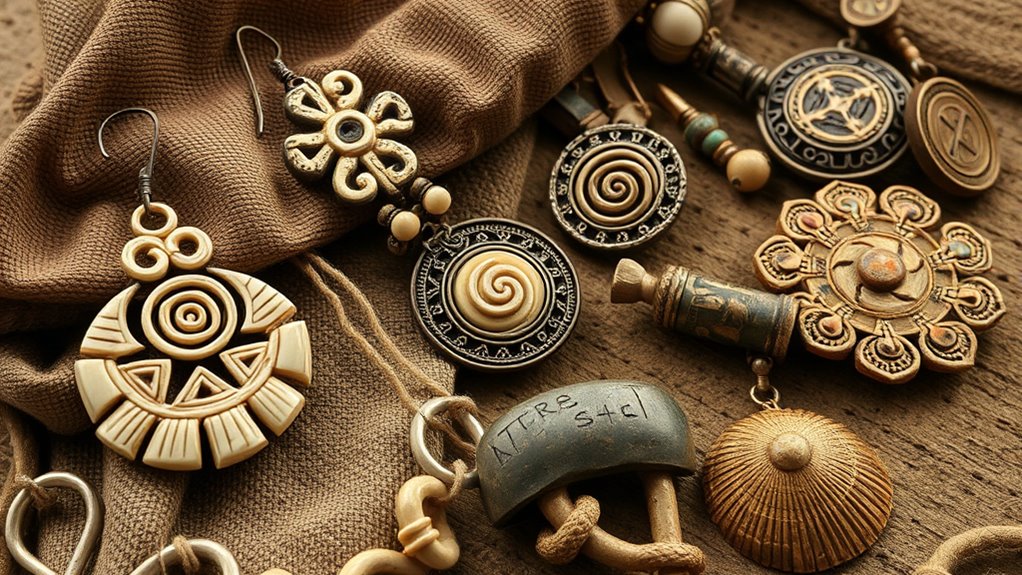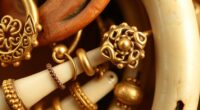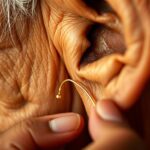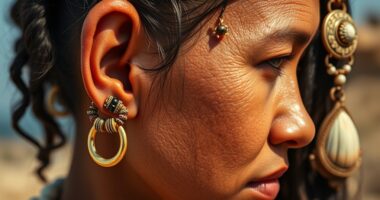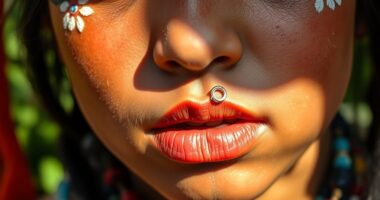In ancient civilizations, piercings weren’t just decorative—they symbolized spiritual beliefs, societal roles, and cultural identity. By piercing specific body parts, people linked themselves to divine forces, ancestors, or spiritual protection. These adornments often marked life shifts or status, serving as powerful symbols woven into rituals, ceremonies, and social hierarchies. If you explore further, you’ll discover how deeply body modification connected individuals to their spiritual world and cultural heritage.
Key Takeaways
- Piercings in ancient civilizations often served as sacred acts during rituals, symbolizing spiritual connection and divine protection.
- Jewelry materials like bones, shells, or metals embodied spiritual meanings and were used in ceremonial piercing practices.
- Piercings indicated societal roles, status, or achievements, reinforcing social hierarchy and cultural identity.
- Rituals involving piercing included chants, offerings, and blessings to invoke spiritual power or ancestral spirits.
- Body modifications like piercings acted as expressions of devotion, linking individuals to spiritual realms and ancestral traditions.

Throughout history, piercings have served as more than just decorative adornments—they’ve held deep spiritual and cultural significance in many ancient civilizations. When you think about piercing rituals, it’s impossible not to see how they functioned as powerful symbols within tribal societies. These adornments weren’t simply fashion statements; they carried profound ritual symbolism that connected individuals to their communities, spiritual beliefs, and ancestral traditions. In many societies, piercing served as a rite of passage, marking your change from one life stage to another, such as from childhood to adulthood or from a commoner to a member of a spiritual elite. The placement of piercings, whether on the ears, nose, lips, or other parts of the body, often conveyed specific meanings tied to spiritual beliefs or societal roles.
Piercings as sacred rites symbolizing spiritual connection, societal roles, and cultural identity throughout history.
In numerous ancient tribes, piercing was a sacred act performed during ceremonies that reinforced communal bonds. These rituals often involved elaborate preparations—chants, offerings, and blessings—that imbued the piercing with spiritual significance. For example, some tribes believed that piercing helped connect the individual to divine forces or ancestral spirits, serving as a conduit for protection, guidance, or spiritual power. The adornments themselves—such as bone, shell, or metal jewelry—became more than decorative objects; they embodied the tribe’s spiritual symbolism, often representing spiritual protection or divine favor. The act of piercing, thus, was a sacred act of devotion, embedding the individual within a larger spiritual framework. Additionally, the types of materials used in piercings often held specific spiritual meanings, further emphasizing their significance.
You must also recognize how these tribal adornments played an essential role in societal identity. Piercings signified belonging, rank, or achievements within the community. For example, warriors might have adorned themselves with specific piercings to demonstrate their bravery or spiritual strength, while others wore particular jewelry to honor deities or ancestors. These symbols served as visual language, conveying complex spiritual and cultural messages to others within the tribe. The ritual symbolism behind piercing was carefully preserved through generations, making it a central element of cultural continuity.
In essence, piercings in ancient civilizations were far more than aesthetic choices; they were powerful tools of spiritual expression and cultural identity. They expressed individual devotion, societal roles, and spiritual beliefs, all woven into the fabric of daily life. As you explore these traditions, it’s clear how deeply intertwined body modification was with spiritual symbolism, serving as a bridge between the physical and spiritual worlds in countless ancient societies.
Frequently Asked Questions
Were Piercings Used as a Form of Spiritual Protection?
Yes, piercings were often used as a form of spiritual protection. You might have seen superstitious practices where people wear piercings as protective talismans, believing they ward off evil spirits or negative energies. These adornments served as more than decoration; they acted as spiritual shields, helping you stay safe and connected to divine or supernatural forces. Piercings, in this way, became powerful symbols of your protection and faith.
How Did Ancient Civilizations Choose Piercing Locations for Spiritual Reasons?
You’re hitting the nail on the head when asking about ancient choices for piercing locations. Ancient civilizations picked spots based on ritual symbolism and ancient symbolism, believing certain areas connected to spiritual power or divine protection. They often chose ears, noses, or lips, aligning with sacred meanings or mythological stories. These placements weren’t random but carefully selected to channel spiritual energy, making piercings essential parts of their ritual practices.
Did Specific Piercings Signify Social or Spiritual Status?
Yes, specific piercings often signified social or spiritual status, acting as adornment symbols that reflected cultural identity. You might notice that ancient civilizations used certain piercings to distinguish leaders, warriors, or spiritual figures. These adornment symbols conveyed power, prestige, or spiritual connection, helping individuals showcase their role within society. By wearing particular piercings, people reinforced their cultural values and spiritual beliefs, making the piercing an important marker of status.
Were Religious Rituals Involving Piercings Performed by Priests or Shamans?
Imagine you’re stepping into a sacred space where piercing tools become symbols of divine connection. Yes, priests and shamans performed religious rituals involving piercings, serving as ritual symbolism and symbolic adornments of spiritual transformation. These acts often marked initiation or communication with deities, emphasizing their role in bridging mortal and divine worlds. Such rituals underscored the belief that piercings could channel spiritual power and deepen sacred bonds.
How Did Spiritual Beliefs Influence the Materials Used in Ancient Piercings?
Your spiritual beliefs shaped the materials used in ancient piercings because they carried symbolic significance and ritual symbolism. You’ll notice that sacred metals like gold or silver, believed to have divine power, were chosen for their spiritual importance. Natural materials like bone or stone also held ritual value, representing connection to ancestors or deities. These choices reflected your culture’s deep belief that the materials could influence spiritual well-being and social status.
Conclusion
As you’ve seen, piercings in ancient civilizations weren’t just about style—they were powerful symbols of spiritual beliefs that shaped entire cultures. Your journey through history reveals how these tiny adornments held the weight of gods, rituals, and identity. Imagine wearing a piece of that ancient magic yourself—piercings that connect you to centuries of spiritual energy. Truly, their significance is nothing short of extraordinary, a demonstration to our timeless desire to find meaning through body art.

